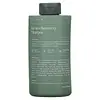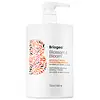What's inside
What's inside
 Key Ingredients
Key Ingredients

 Benefits
Benefits

 Concerns
Concerns

 Ingredients Side-by-side
Ingredients Side-by-side

Water
Skin ConditioningDisodium Laureth Sulfosuccinate
CleansingCoco-Betaine
CleansingLauryl Glucoside
CleansingCocamide Mipa
EmulsifyingSodium Cocoyl Isethionate
CleansingAcacia Concinna Fruit Extract
Skin ConditioningLactobacillus/Rice Ferment
Skin ConditioningBiotin
AntiseborrhoeicPanthenol
Skin ConditioningCocos Nucifera Oil
MaskingCaffeine
Skin ConditioningMelaleuca Alternifolia Leaf Oil
AntioxidantMentha Piperita Oil
MaskingCurcuma Longa Leaf Extract
Skin ConditioningPanax Ginseng Root Extract
EmollientNiacinamide
SmoothingRosmarinus Officinalis Leaf Oil
MaskingAcorus Calamus Root Extract
PerfumingCamellia Sinensis Leaf Extract
AntimicrobialCitrus Paradisi Fruit Extract
Skin ConditioningSimmondsia Chinensis Seed Oil
EmollientMalt Extract
Skin ProtectingPrunus Amygdalus Dulcis Oil
Skin ConditioningArgania Spinosa Kernel Oil
EmollientPlukenetia Volubilis Seed Oil
EmollientMacadamia Ternifolia Seed Oil
EmollientTocopheryl Acetate
AntioxidantMenthol
MaskingHydrolyzed Collagen
EmollientHydrolyzed Keratin
HumectantCeramide NP
Skin ConditioningCitric Acid
BufferingStyrene/Acrylates Copolymer
Polyquaternium-10
Hydroxyacetophenone
AntioxidantParfum
MaskingCitral
PerfumingLimonene
PerfumingWater, Disodium Laureth Sulfosuccinate, Coco-Betaine, Lauryl Glucoside, Cocamide Mipa, Sodium Cocoyl Isethionate, Acacia Concinna Fruit Extract, Lactobacillus/Rice Ferment, Biotin, Panthenol, Cocos Nucifera Oil, Caffeine, Melaleuca Alternifolia Leaf Oil, Mentha Piperita Oil, Curcuma Longa Leaf Extract, Panax Ginseng Root Extract, Niacinamide, Rosmarinus Officinalis Leaf Oil, Acorus Calamus Root Extract, Camellia Sinensis Leaf Extract, Citrus Paradisi Fruit Extract, Simmondsia Chinensis Seed Oil, Malt Extract, Prunus Amygdalus Dulcis Oil, Argania Spinosa Kernel Oil, Plukenetia Volubilis Seed Oil, Macadamia Ternifolia Seed Oil, Tocopheryl Acetate, Menthol, Hydrolyzed Collagen, Hydrolyzed Keratin, Ceramide NP, Citric Acid, Styrene/Acrylates Copolymer, Polyquaternium-10, Hydroxyacetophenone, Parfum, Citral, Limonene
Water
Skin ConditioningSodium Cocoyl Isethionate
CleansingCocamidopropyl Hydroxysultaine
CleansingLauramidopropyl Betaine
CleansingGlycerin
HumectantDisodium Laureth Sulfosuccinate
CleansingPolysorbate 80
EmulsifyingSodium Lauryl Sulfoacetate
CleansingSoyamidopropylamine Oxide
CleansingMaltodextrin
AbsorbentBiotin
AntiseborrhoeicPanthenol
Skin ConditioningPanax Ginseng Root Extract
EmollientZingiber Officinale Extract
Skin ConditioningZingiber Officinale Root Oil
MaskingTocopheryl Acetate
AntioxidantAloe Barbadensis Leaf Juice
Skin ConditioningArgania Spinosa Kernel Oil
EmollientCitrus Aurantium Dulcis Peel Oil
MaskingCitrus Grandis Peel Oil
MaskingCitrus Tangerina Peel Oil
MaskingCocos Nucifera Oil
MaskingLavandula Angustifolia Oil
MaskingMentha Viridis Leaf Oil
AstringentSantalum Album Oil
MaskingSodium C14-18 Olefin Sulfonate
CleansingSodium Cocoyl Glutamate
CleansingSodium Lauroyl Sarcosinate
CleansingPolyquaternium-7
Polyquaternium-71
HumectantParfum
MaskingCitric Acid
BufferingBenzyl Alcohol
PerfumingDehydroacetic Acid
PreservativeCoconut Acid
CleansingVegetable Oil
Skin ConditioningPlant Ash
Water, Sodium Cocoyl Isethionate, Cocamidopropyl Hydroxysultaine, Lauramidopropyl Betaine, Glycerin, Disodium Laureth Sulfosuccinate, Polysorbate 80, Sodium Lauryl Sulfoacetate, Soyamidopropylamine Oxide, Maltodextrin, Biotin, Panthenol, Panax Ginseng Root Extract, Zingiber Officinale Extract, Zingiber Officinale Root Oil, Tocopheryl Acetate, Aloe Barbadensis Leaf Juice, Argania Spinosa Kernel Oil, Citrus Aurantium Dulcis Peel Oil, Citrus Grandis Peel Oil, Citrus Tangerina Peel Oil, Cocos Nucifera Oil, Lavandula Angustifolia Oil, Mentha Viridis Leaf Oil, Santalum Album Oil, Sodium C14-18 Olefin Sulfonate, Sodium Cocoyl Glutamate, Sodium Lauroyl Sarcosinate, Polyquaternium-7, Polyquaternium-71, Parfum, Citric Acid, Benzyl Alcohol, Dehydroacetic Acid, Coconut Acid, Vegetable Oil, Plant Ash
Ingredients Explained
These ingredients are found in both products.
Ingredients higher up in an ingredient list are typically present in a larger amount.
You may know this ingredient as argan oil. Argan Oil has antioxidant, hydrating, and soothing properties.
Studies have shown argan oil can help fight again radical damage from the sun. This makes it effective at preventing hyperpigmentation.
Large amounts of vitamin E found in argan oil helps the skin retain water. Argan oil also contains fatty acids such as linoleic acid, oleic acid, and palmitic acid. It is also a good source of lipids.
Another benefit of argan oil is skin-soothing. It can help reduce inflammation-related skin symptoms.
Argan Oil is effective at regulating sebum production in pores. This can make it effective at treating hormonal acne.
Traditionally, argan oil was used for its antibacterial and antifungal properties. However, argan oil contains fatty acids that may make it not fungal-acne safe.
Argan Trees are native to Morocco.
Learn more about Argania Spinosa Kernel OilBiotin is a B vitamin that is naturally produced by our bodies. It is also called Vitamin H.
Our bodies use biotin in the metabolism process. It also helps our bodies use enzymes and move nutrients around. A biotin deficiency can lead to brittle hair and nails.
More research is needed on applying biotin topically. However, taking biotin orally has been shown to help nourish the skin, hair, and nails. They play a role in forming skin-hydrating fatty acids.
Biotin is water-soluble. It can be found in foods such as fish, eggs, dairy, nuts, and meat. Vitamin H stands for "haar" and "haut". These are the German words for hair and skin.
Learn more about BiotinCitric Acid is an alpha hydroxy acid (AHA) naturally found in citrus fruits like oranges, lemons, and limes.
Like other AHAs, citric acid can exfoliate skin by breaking down the bonds that hold dead skin cells together. This helps reveal smoother and brighter skin underneath.
However, this exfoliating effect only happens at high concentrations (20%) which can be hard to find in cosmetic products.
Due to this, citric acid is usually included in small amounts as a pH adjuster. This helps keep products slightly more acidic and compatible with skin's natural pH.
In skincare formulas, citric acid can:
While it can provide some skin benefits, research shows lactic acid and glycolic acid are generally more effective and less irritating exfoliants.
Most citric acid used in skincare today is made by fermenting sugars (usually from molasses). This synthetic version is identical to the natural citrus form but easier to stabilize and use in formulations.
Read more about some other popular AHA's here:
Learn more about Citric AcidCocos Nucifera Oil is obtained from the kernels of the coconut fruit. In other words, this is coconut oil.
Coconut Oil is rich in fatty acids with lauric acid making up the majority of these. It also contains linoleic acid. Due to this high fatty acid content, coconut oil helps trap moisture and soften skin.
Despite being antibacterial, coconut oil may not be great for acne-prone skin. It is comedogenic and may clog pores. This ingredient may not be safe for malassezia or fungal acne.
Note: Coconut Oil should not replace your sunscreen for UV protection. Studies show it only blocks about 20% of UV.
This oil is non-volatile and has a light scent.
The term 'fragrance' is not regulated in many countries. In many cases, it is up to the brand to define this term. For instance, many brands choose to label themselves as "fragrance-free" because they are not using synthetic fragrances. However, their products may still contain ingredients such as essential oils that are considered a fragrance.
Learn more about Cocos Nucifera OilThis ingredient is a cleansing agent, surfactant, and foam booster. It considered an alternative to traditional sulfates (Sulfosuccinate) and is allowed in "sulfate-free" products.
According to a manufacturer, this ingredient is mild and can be used in baby and bath options.
Ginseng root is a well-loved ingredient in Asian skincare for good reason. It hydrates the skin, soothes irritation, and helps even out skin tone.
In traditional East Asian medicine, ginseng has been used for centuries both as food and as a healing remedy, and modern research continues to confirm its skin benefits.
One of the standout features of ginseng is its ability to improve blood circulation and oxygen delivery to the skin, bringing a fresh supply of nutrients to support overall skin health. It also has antioxidant and anti-inflammatory properties. This helps to protect your skin against damage from UV exposure, pollution, and daily stress.
Additionally, studies suggest that ginseng may help reduce hyperpigmentation by inhibiting tyrosinase, the enzyme involved in melanin production.
There are different types of ginseng used in skincare, and while they all share core benefits, their potency can vary.
Most products use fresh or white ginseng because it’s more affordable. However, red ginseng, produced by steaming the root, contains higher levels of ginsenosides, which are compounds with proven anti-aging effects. These ginsenosides help reduce the appearance of wrinkles and improve skin elasticity.
Note: All forms of ginseng are listed simply as “Panax ginseng” in ingredient lists. We recommend reaching out to the brand if you have questions about which type of ginseng is used in their ingredients.
For general antioxidant benefits, any ginseng extract will do, but for wrinkle care or firmer skin, red or fermented ginseng is often more effective.
In short, ginseng is a powerhouse ingredient that supports hydration, radiance, and resilience.
Learn more about Panax Ginseng Root ExtractPanthenol is a common ingredient that helps hydrate and soothe the skin. It is found naturally in our skin and hair.
There are two forms of panthenol: D and L.
D-panthenol is also known as dexpanthenol. Most cosmetics use dexpanthenol or a mixture of D and L-panthenol.
Panthenol is famous due to its ability to go deeper into the skin's layers. Using this ingredient has numerous pros (and no cons):
Like hyaluronic acid, panthenol is a humectant. Humectants are able to bind and hold large amounts of water to keep skin hydrated.
This ingredient works well for wound healing. It works by increasing tissue in the wound and helps close open wounds.
Once oxidized, panthenol converts to pantothenic acid. Panthothenic acid is found in all living cells.
This ingredient is also referred to as pro-vitamin B5.
Learn more about PanthenolParfum is a catch-all term for an ingredient or more that is used to give a scent to products.
Also called "fragrance", this ingredient can be a blend of hundreds of chemicals or plant oils. This means every product with "fragrance" or "parfum" in the ingredients list is a different mixture.
For instance, Habanolide is a proprietary trade name for a specific aroma chemical. When used as a fragrance ingredient in cosmetics, most aroma chemicals fall under the broad labeling category of “FRAGRANCE” or “PARFUM” according to EU and US regulations.
The term 'parfum' or 'fragrance' is not regulated in many countries. In many cases, it is up to the brand to define this term.
For instance, many brands choose to label themselves as "fragrance-free" because they are not using synthetic fragrances. However, their products may still contain ingredients such as essential oils that are considered a fragrance by INCI standards.
One example is Calendula flower extract. Calendula is an essential oil that still imparts a scent or 'fragrance'.
Depending on the blend, the ingredients in the mixture can cause allergies and sensitivities on the skin. Some ingredients that are known EU allergens include linalool and citronellol.
Parfum can also be used to mask or cover an unpleasant scent.
The bottom line is: not all fragrances/parfum/ingredients are created equally. If you are worried about fragrances, we recommend taking a closer look at an ingredient. And of course, we always recommend speaking with a professional.
Learn more about ParfumSodium cocoyl isethionate is a natural ingredient from coconut oil. It is an ultra gentle cleanser that gives a nice foam without drying the skin or impacting the skin barrier.
The amount of foam created depends on the amount of sodium cocoyl isethionate used in the product.
This ingredient also helps improve the spreadability of a product.
Learn more about Sodium Cocoyl IsethionateTocopheryl Acetate is AKA Vitamin E. It is an antioxidant and protects your skin from free radicals. Free radicals damage the skin by breaking down collagen.
One study found using Tocopheryl Acetate with Vitamin C decreased the number of sunburned cells.
Tocopheryl Acetate is commonly found in both skincare and dietary supplements.
Learn more about Tocopheryl AcetateWater. It's the most common cosmetic ingredient of all. You'll usually see it at the top of ingredient lists, meaning that it makes up the largest part of the product.
So why is it so popular? Water most often acts as a solvent - this means that it helps dissolve other ingredients into the formulation.
You'll also recognize water as that liquid we all need to stay alive. If you see this, drink a glass of water. Stay hydrated!
Learn more about Water